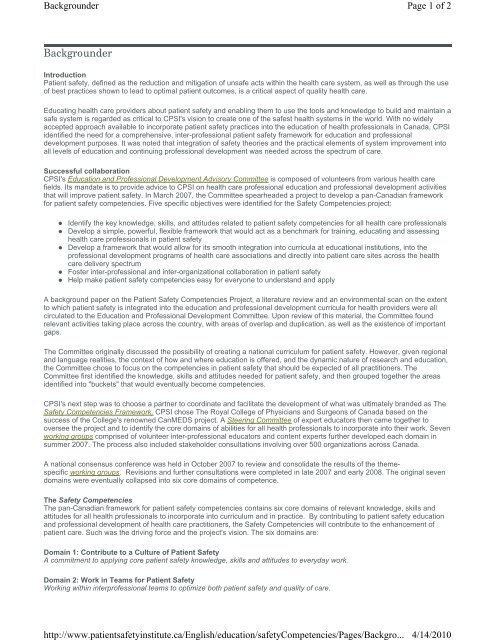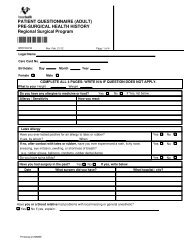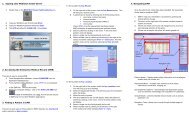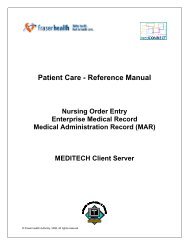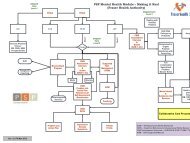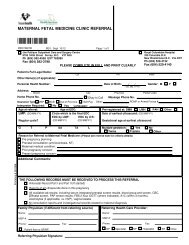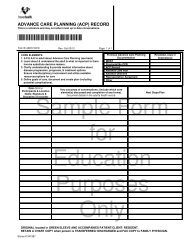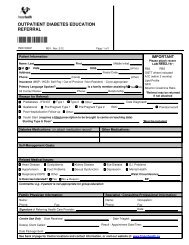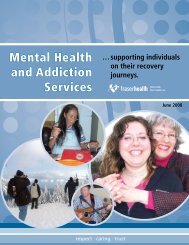Background paper on the Patient Safety Competencies ... - Physician
Background paper on the Patient Safety Competencies ... - Physician
Background paper on the Patient Safety Competencies ... - Physician
You also want an ePaper? Increase the reach of your titles
YUMPU automatically turns print PDFs into web optimized ePapers that Google loves.
<str<strong>on</strong>g>Background</str<strong>on</strong>g>erhttp://www.patientsafetyinstitute.ca/English/educati<strong>on</strong>/safety<strong>Competencies</strong>/Pages/Backgro...Page 1 of 24/14/2010<str<strong>on</strong>g>Background</str<strong>on</strong>g>erIntroducti<strong>on</strong><strong>Patient</strong> safety, defined as <strong>the</strong> reducti<strong>on</strong> and mitigati<strong>on</strong> of unsafe acts within <strong>the</strong> health care system, as well as through <strong>the</strong> useof best practices shown to lead to optimal patient outcomes, is a critical aspect of quality health care.Educating health care providers about patient safety and enabling <strong>the</strong>m to use <strong>the</strong> tools and knowledge to build and maintain asafe system is regarded as critical to CPSI's visi<strong>on</strong> to create <strong>on</strong>e of <strong>the</strong> safest health systems in <strong>the</strong> world. With no widelyaccepted approach available to incorporate patient safety practices into <strong>the</strong> educati<strong>on</strong> of health professi<strong>on</strong>als in Canada, CPSIidentified <strong>the</strong> need for a comprehensive, inter-professi<strong>on</strong>al patient safety framework for educati<strong>on</strong> and professi<strong>on</strong>aldevelopment purposes. It was noted that integrati<strong>on</strong> of safety <strong>the</strong>ories and <strong>the</strong> practical elements of system improvement intoall levels of educati<strong>on</strong> and c<strong>on</strong>tinuing professi<strong>on</strong>al development was needed across <strong>the</strong> spectrum of care.Successful collaborati<strong>on</strong>CPSI's Educati<strong>on</strong> and Professi<strong>on</strong>al Development Advisory Committee is composed of volunteers from various health carefields. Its mandate is to provide advice to CPSI <strong>on</strong> health care professi<strong>on</strong>al educati<strong>on</strong> and professi<strong>on</strong>al development activitiesthat will improve patient safety. In March 2007, <strong>the</strong> Committee spearheaded a project to develop a pan-Canadian frameworkfor patient safety competencies. Five specific objectives were identified for <strong>the</strong> <strong>Safety</strong> <strong>Competencies</strong> project:• Identify <strong>the</strong> key knowledge, skills, and attitudes related to patient safety competencies for all health care professi<strong>on</strong>als• Develop a simple, powerful, flexible framework that would act as a benchmark for training, educating and assessinghealth care professi<strong>on</strong>als in patient safety• Develop a framework that would allow for its smooth integrati<strong>on</strong> into curricula at educati<strong>on</strong>al instituti<strong>on</strong>s, into <strong>the</strong>professi<strong>on</strong>al development programs of health care associati<strong>on</strong>s and directly into patient care sites across <strong>the</strong> healthcare delivery spectrum• Foster inter-professi<strong>on</strong>al and inter-organizati<strong>on</strong>al collaborati<strong>on</strong> in patient safety• Help make patient safety competencies easy for every<strong>on</strong>e to understand and applyA background <str<strong>on</strong>g>paper</str<strong>on</strong>g> <strong>on</strong> <strong>the</strong> <strong>Patient</strong> <strong>Safety</strong> <strong>Competencies</strong> Project, a literature review and an envir<strong>on</strong>mental scan <strong>on</strong> <strong>the</strong> extentto which patient safety is integrated into <strong>the</strong> educati<strong>on</strong> and professi<strong>on</strong>al development curricula for health providers were allcirculated to <strong>the</strong> Educati<strong>on</strong> and Professi<strong>on</strong>al Development Committee. Up<strong>on</strong> review of this material, <strong>the</strong> Committee foundrelevant activities taking place across <strong>the</strong> country, with areas of overlap and duplicati<strong>on</strong>, as well as <strong>the</strong> existence of importantgaps.The Committee originally discussed <strong>the</strong> possibility of creating a nati<strong>on</strong>al curriculum for patient safety. However, given regi<strong>on</strong>aland language realities, <strong>the</strong> c<strong>on</strong>text of how and where educati<strong>on</strong> is offered, and <strong>the</strong> dynamic nature of research and educati<strong>on</strong>,<strong>the</strong> Committee chose to focus <strong>on</strong> <strong>the</strong> competencies in patient safety that should be expected of all practiti<strong>on</strong>ers. TheCommittee first identified <strong>the</strong> knowledge, skills and attitudes needed for patient safety, and <strong>the</strong>n grouped toge<strong>the</strong>r <strong>the</strong> areasidentified into "buckets" that would eventually become competencies.CPSI's next step was to choose a partner to coordinate and facilitate <strong>the</strong> development of what was ultimately branded as The<strong>Safety</strong> <strong>Competencies</strong> Framework. CPSI chose The Royal College of <strong>Physician</strong>s and Surge<strong>on</strong>s of Canada based <strong>on</strong> <strong>the</strong>success of <strong>the</strong> College's renowned CanMEDS project. A Steering Committee of expert educators <strong>the</strong>n came toge<strong>the</strong>r tooversee <strong>the</strong> project and to identify <strong>the</strong> core domains of abilities for all health professi<strong>on</strong>als to incorporate into <strong>the</strong>ir work. Sevenworking groups comprised of volunteer inter-professi<strong>on</strong>al educators and c<strong>on</strong>tent experts fur<strong>the</strong>r developed each domain insummer 2007. The process also included stakeholder c<strong>on</strong>sultati<strong>on</strong>s involving over 500 organizati<strong>on</strong>s across Canada.A nati<strong>on</strong>al c<strong>on</strong>sensus c<strong>on</strong>ference was held in October 2007 to review and c<strong>on</strong>solidate <strong>the</strong> results of <strong>the</strong> <strong>the</strong>mespecificworking groups. Revisi<strong>on</strong>s and fur<strong>the</strong>r c<strong>on</strong>sultati<strong>on</strong>s were completed in late 2007 and early 2008. The original sevendomains were eventually collapsed into six core domains of competence.The <strong>Safety</strong> <strong>Competencies</strong>The pan-Canadian framework for patient safety competencies c<strong>on</strong>tains six core domains of relevant knowledge, skills andattitudes for all health professi<strong>on</strong>als to incorporate into curriculum and in practice. By c<strong>on</strong>tributing to patient safety educati<strong>on</strong>and professi<strong>on</strong>al development of health care practiti<strong>on</strong>ers, <strong>the</strong> <strong>Safety</strong> <strong>Competencies</strong> will c<strong>on</strong>tribute to <strong>the</strong> enhancement ofpatient care. Such was <strong>the</strong> driving force and <strong>the</strong> project's visi<strong>on</strong>. The six domains are:Domain 1: C<strong>on</strong>tribute to a Culture of <strong>Patient</strong> <strong>Safety</strong>A commitment to applying core patient safety knowledge, skills and attitudes to everyday work.Domain 2: Work in Teams for <strong>Patient</strong> <strong>Safety</strong>Working within interprofessi<strong>on</strong>al teams to optimize both patient safety and quality of care.
<str<strong>on</strong>g>Background</str<strong>on</strong>g>erhttp://www.patientsafetyinstitute.ca/English/educati<strong>on</strong>/safety<strong>Competencies</strong>/Pages/Backgro...Page 2 of 24/14/2010Domain 3: Communicate Effectively for <strong>Patient</strong> <strong>Safety</strong>Promoting patient safety through effective health care communicati<strong>on</strong>.Domain 4: Manage <strong>Safety</strong> RisksAnticipating, recognizing and managing situati<strong>on</strong>s that place patients at risk.Domain 5: Optimize Human and Envir<strong>on</strong>mental FactorsManaging <strong>the</strong> relati<strong>on</strong>ship between individual and envir<strong>on</strong>mental characteristics in order to optimize patient safety.Domain 6: Recognize, Resp<strong>on</strong>d to and Disclose Adverse EventsRecognizing <strong>the</strong> occurrence of an adverse event or close call and resp<strong>on</strong>ding effectively to mitigate harm to <strong>the</strong> patient,ensure disclosure, and prevent recurrence.Disseminati<strong>on</strong> and Stakeholder EngagementDuring this phase of <strong>the</strong> project, CPSI is using a multiple launch strategy to share <strong>the</strong> <strong>Safety</strong> <strong>Competencies</strong> Framework. CPSIhas identified a number of different target audiences who can strategically assist in disseminating <strong>the</strong> <strong>Safety</strong> <strong>Competencies</strong>and in accelerating <strong>the</strong>ir uptake am<strong>on</strong>g <strong>the</strong> various stakeholders. The goal is to share <strong>the</strong> competencies, have <strong>the</strong>m integratedinto curricula, and used by health care professi<strong>on</strong>als in practice.Please write to safetycomp@cpsi-icsp.ca, or visit <strong>the</strong> dedicated website at www.safetycomp.ca for more informati<strong>on</strong> <strong>on</strong> <strong>the</strong><strong>Safety</strong> <strong>Competencies</strong>.1 The Royal College of <strong>Physician</strong>s and Surge<strong>on</strong>s of Canada. The Canadian <strong>Patient</strong> <strong>Safety</strong> Dicti<strong>on</strong>ary, 2003, p.12.


